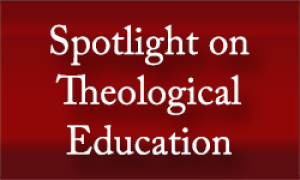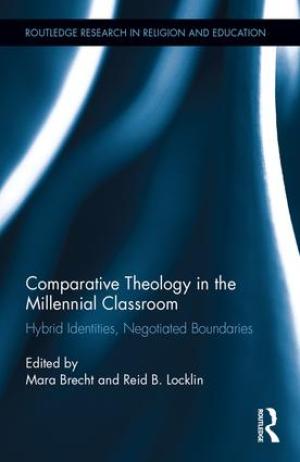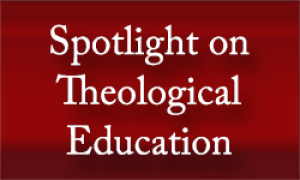Resources
Syllabi of five courses taught within new interfaith and interreligious studies programs. Also  model student learning outcomes and curricular programs. 
From its beginnings, Georgetown College welcomed students of all faiths. Today, that imperative finds roots in the Vatican II document Nostra Aetate and serves the good of interreligious dialogue in a globalized world. Georgetown describes its posture as “centered pluralism,” remaining in the Catholic tradition while engaging in conversation with others. An ongoing challenge is how to remain centered in Catholic tradition and at the same time be truly open to encounter with the religious other. (From the Publisher)

Journal Issue. Full text is available online.

Click Here for Book Review Abstract: This volume explores the twenty-first century classroom as a uniquely intergenerational space of religious disaffiliation, and questions about how our work in the classroom can be, and is being, re-imagined for the new generation. The culturally hybrid identity of Millennials shapes their engagement with religious "others" on campus and in the classroom, pushing educators of comparative theology to develop new pedagogical strategies that leverage ways of seeing and interacting with their teachers and classmates. Reflecting on religious traditions such as Islam, Judaism, African Traditional Religions, Hinduism, Christianity, and agnosticism/atheism, this volume theorizes the theological outcomes of current pedagogies and the shifting contours of comparative theological discourse. (From the Publisher)

Journal Issue. Full text is available online.

Working with undergraduate students invites teachers into relationship and conversation with young people at a time when they are emerging as adults and forming their identities. Faith is one area of identity formation often attended to by scholars, college professors, and their institutions. But within that, little attention has been paid to those who do not identify as religious. Additionally, “the overwhelming presence of Christianity at American institutions maintains it as the spiritual norm on campus. … Those within the spiritual norm gain a level of privilege that is often unconscious” (Seifert 2007, 11). This has an effect not only on nonreligious students but on any student who identifies as anything other than Christian; and it has a unique effect on teaching and learning in the religion classroom. In this article, I will explain what Christian privilege is, why it is a unique problem in the undergraduate religion classroom, and what teachers of religion might do in response to it. In the end, I argue that educators need to better understand the effects of Christian privilege in our classrooms and become allies to the nonreligious in particular by using pedagogies that include and support all students, in their many religious affiliations and unaffiliations.
Conservative (fundamentalist, evangelical) Christian students present a general theological worldview that often correlates with significant anxiety. In a foreign setting, the anxiety of conservative students, removed from their supportive infrastructure, can be considerably heightened. This structure of thinking and emotion presents distinctive challenges and opportunities. Drawing upon my work as a clinician and as a religion professor who conducted study abroad programs, I make suggestions for working effectively with conservative Christian students in study abroad contexts. Suggestions include predeparture, in-country, and post-trip strategies. Specific examples of conversations with students are provided to illustrate the challenges and strategies. This essay is published alongside of seven other essays, including a response from John Barbour, comprising a special section of the journal (see Teaching Theology and Religion 18:1, January 2015).
Reflecting on two study abroad trips to New Zealand in 2005 and 2007, I suggest in this essay that it is possible to mitigate the risk of (American or European) students recapitulating imperial attitudes through development of a rigorous curriculum focusing on the legacies of colonialism, institutional racism, and the somewhat dubious phenomenon of “post-colonialism.” Readings, I argue, should be in continual play during cultural and social activities, operating in a dialectal move toward an “ethics of respect.” Such an ethics remains aporetic, or uncertain, insofar as no code of behavior can render us immune to the political and polemical effects of past and present forms of imperialism. However, a cultivated respect for distance and difference, including regarding questions of “authenticity,” can help to actualize the transformative promise of studying (indigenous) religion abroad. This essay is published alongside of six other essays, including a response from John Barbour, comprising a special section of the journal (see Teaching Theology and Religion 18:1, January 2015).
This essay is concerned with study abroad experiences as opportunities for student cognitive development, using the interpretive lens of educational psychologist William G. Perry. A standard and often valuable assignment in courses on world religions is a site visit to a religious institution in one's local area. This may concretize otherwise abstract materials and help students reflect on ways in which the lived experience of religion differs from its presentation in course texts and other academic materials. Increasingly, study abroad trips are being offered as extended and more intensive ways of bringing this material to life, offering students opportunity to see lived religion within another cultural framework. At the heart of this paper is the contention that such study abroad experiences function not simply as longer, more intense versions of site visits but, rather, as experiences that invert the subject and object of study. The worldview of the student becomes a primary object of study, which is examined, as it were, by the particulars of the religion(s) under investigation and the cultures of which said religion(s) are a part. Where site visits offer students an opportunity to visit the strange amidst the familiar, study abroad trips provide opportunities for students to become the strange within a recalibrated familiar. The subject becomes the object and is interrogated by the context of study. While local, stateside site visits can offer a degree of such dislocation, their brevity, together with some degree of assimilation to the larger culture flows on the part of the local religious institution being visited, most often mitigates any significant inversion. Students generally see such institutions as either mildly or wildly exotic, but always within their frame of reference, which constitutes the norm. When abroad, the normative experience of students is often subverted in ways that lay bare the assumptions behind such views and makes possible another world in which to live. Simply put, the subject and object of study change places. If this inversion is carefully attended to, it can provide rich insight into not only the topics nominally being studied but also occasion opportunity for real cognitive development on the part of the student. This essay is published alongside of six other essays, including a response from John Barbour, comprising a special section of the journal (see Teaching Theology and Religion 18:1, January 2015).
This paper discusses strategies I employed during seven years of teaching within a study abroad program focusing on religion. This year-long program traveled to four Asian countries and included immersion experiences in monasteries, ashrams, and other religious institutions. I identify four principles and discuss accompanying exercises that guided my teaching: (1) Accept and observe anxiety. Inability to understand is a sign that direct and deep contact is taking place. (2) Educate about education. Help students to see the aims, assumptions, and context of the teaching strategies religious practitioners employ. (3) Make it practical. Devise exercises that students can do and do well and that do not demand synthetic, systematic comprehension even as a goal. (4) Stop making sense. Build pauses and breaks into the train of reflection on the meaning of experience. These spaces give room for the shifts in the ways of learning that study abroad demands. This essay is published alongside of six other essays, including a response from John Barbour, comprising a special section of the journal (see Teaching Theology and Religion 18:1, January 2015).